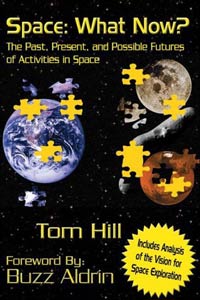Review: Space: What Now?by Jeff Foust
|
| Hill outlines his vision for space exploration, which has as its long-term goal human expeditions to Mars, but only after completing the International Space Station, building up infrastructure in Earth orbit, and getting experience with missions to high Earth orbit, the Moon, and near Earth asteroids. |
With this foundation in place, Hill then takes the reader on an exploration of future possibilities in space. In one chapter he makes a strong case for developing on-orbit depots, storing water (launched commercially at a high enough flight rate to help bring down launch costs in the process) that can be used to support human missions beyond the Earth, including breaking down the water into hydrogen and oxygen as propellant. Hill also examines the pros and cons of various destinations for human missions, including the Moon, near Earth asteroids, and Mars. Hill is most supportive of Mars—no surprise given his Mars Society membership—but gives the other options a fair shake. Hill also looks at various mechanisms for funding such exploration, leaning in favor of a hybrid government-commercial approach outlined in the book.
One problem with Space: What Now? is its editing. While the book is not rife with errors, there are a number of minor typos, primarily with proper names (“Spaceshipone” and “Harrison Schmidt” are two such examples). This suggests the possibility of an editor at the publisher being perhaps a little too helpful. A better editor could have also helped tighten up the book: there are a number of asides in the text that, while entertaining and/or enlightening, distract the reader from the central point of a given passage. The book’s index is a little weak, only a few pages of long and listing only the major names and concepts discussed in the text. Another minor, unavoidable issue is that developments have occurred since Hill finished the book in late 2004, although he does offer a web site (www.spacewhatnow.com) where he offers updates as well as related commentary on space issues.
A bigger issue, though, is the purpose of, and the audience for, this book. Other than advocating for space exploration in general, Hill doesn’t take any strong stands on major issues, other than the ones cites above, until late in the book. In a chapter titled “Yes, but What Should Happen Now?”, Hill outlines his vision for space exploration, which has as its long-term goal human expeditions to Mars, but only after completing the International Space Station, building up infrastructure in Earth orbit, and getting experience with missions to high Earth orbit, the Moon, and near Earth asteroids. (He acknowledges that much of this sounds like the Vision for Space Exploration unveiled by President Bush in January 2004; in his defense he notes that he developed much of this independently prior to that Presidential announcement.) However, tacked on towards the end of the book, it is not nearly as compelling a case had it been woven throughout the manuscript, with each section providing support for that concept. Compare this to Zubrin and Wagner’s The Case for Mars, which—even if you disagree with the idea of human missions to Mars—makes a very compelling argument because each section of the book builds up and supports the proposal.
In the end, it seems that the target audience for Space: What Now? is not primarily space professionals and enthusiasts, but a broader audience of people who may have some interest in, but not necessarily a lot of knowledge about, space exploration. (Hill acknowledges this to some degree in the text: fearing oversimplification in a discussion about travel times for human Mars expeditions, he feels compelled to point out that “I’m bringing that up mainly for the folks who are reading this book to watch me drop something technically so that they can say I don’t know what I’m talking about.”) For them, the book will offer a useful primer on space activities as well as make the case for future exploration. For those already knowledgeable about space, much of the first part of the book will be a review that can be quickly skimmed, although the latter portions of the book, where he discusses his proposals for future exploration and helps answer the question that is the title of his book—what now?—are still worthwhile.
